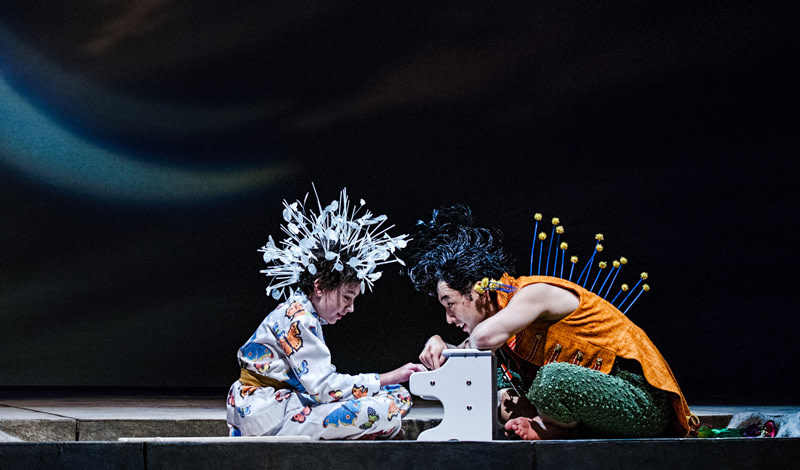Review: PCS's A Midsummer Night's Dream

Daisuke Tsuji as Puck teaches the changeling child (Dylan Earhart) to play. Photo by Patrick Weishampel.
The fairy Puck closes Shakespeare’s A Midsummer Night’s Dream with an apology: “If we shadows have offended, think but this, and all is mended: that you have but slumber'd here, while these visions did appear.” While Portland Center Stage’s production of the Bard’s most famous comedy is far from offensive—only one unexpected pantomime even approaches a racy tone—the incongruous nature of its choices did befuddle, leaving me with the sense that it was Shakespeare set in the time of Disney.
Director Penny Metropulos, a veteran of the Oregon Shakespeare Festival whose last turn at the PCS helm for An Iliad was excellent, chooses an approach to the play made famous by English director Peter Brook in the early 1970s, where the same actors play the mortal king and queen as the fairy king and queen (finely performed here in both garb by Richard Baird and Dana Green), while the performers playing the troupe of actors also double as fairies. The effect is to blur the line between the mortal and the magical, making it seem they are two sides of the same coin, which is the only explanation I can see for the production perplexities to come.
The scenic and lighting design, gorgeously executed by Michael Vaughn Sims and Diane Ferry Williams, has the surreal enchantment of a Maxfield Parrish painting: curtains and chandeliers seemingly hang from trees that grow from stone steps, and magnificent moons light up the backdrop. But the set’s fairy-world timelessness clashes harshly with the mortals’ costumes, by Deborah M. Dryden. The floral prints, petal pushers, and bright jewelry on the girls and popped collars, jeans, and chinos on the guys seem to be going for a 1990s after school special–take on the 50s.
Then there’s the theater troupe of laborers, who are dressed like the Village People, if the VP had come from a small British hamlet (the only Village People in the village!). There’s the tailor in tweed, the utility worker in a hardhat, a gardener, a chimney sweep (?), and the self-centered Nick Bottom as a roofer in overalls who gets turned into an ass to romance the fairy queen Titania. Bottom is exuberantly performed by James Newcom—with an inexplicable Southern twang.
In contrast to the incongruity of our mortal characters, the regalia and performances of the fairies are consistent and—I hate to use the word because it seems an insult to a fairy—logical. Their costumes beautifully incorporate flowers and thistles and butterflies, and their performances strike a fanciful balance between elegance and mischief.
A particular joy is the musicality and physicality injected by Daisuke Tsuji as Puck. A veteran clown who has performed with Cirque Du Soleil, he plunks at a toy piano and strums a ukulele before disappearing into the roots of a tree, making the hobgoblin into a spriteful circus troubadour of sorts. One wishes he did all the production’s sounds, as the sound effects used for the rest of the show, particularly for moments of magic, have the Casio cheesiness of old school computer games.
The production plays up the humor of Shakespeare’s script, laudably making it bare for even the most non-Shakespeare literate viewer—and likely entertaining for the Shakespeare averse teen. Not only do the players emphasize the rich tongue in cheek–nature of the verse, but they crank the physical humor up to slapstick levels—to particularly great effect in the final play within the play, although to less great effect during the lovers’ squabbles.
Many in the audience seemed charmed by the production—the laughter rolled freely—and the Oregonian wrote, “the evening sparkles with perfection” (although we've now seen, allegedly, what happens when a newspaper gives PCS too many critical reviews). But for me, the cumulative result of the goofily mishmashed sound effects, costumes, blocking, and performances was the feeling of a campy Disney production of A Midsummer Night’s Dream. The four lovers in particular—played by Kayla Lian, Jenni Putney, Joel Gelman, and Post5 Theatre’s Ty Boice—feel like petulant characters from My So Called Life or Girls as filtered through the bright Disney lens to be safe and accessible to children. I kept waiting for Whoopi Goldberg, Whitney Houston, or some other mature celebrity to come floating in on a giant bubble as Titania (although diversity was the one Disney trait the production lacked).
Metropulos writes in her “Director’s Note” that A Midsummer Night’s Dream leads us into the world of Dream where situations are puzzling and perplexing but can restores order to our own world. Perhaps the incongruities are on purpose and I missed the point, but in this production, it is the world of fairy that makes sense, and the world of mortals that is instead perplexing.
A Midsummer Night's Dream runs at Portland Center Stage through December 23. For more info, click here.




